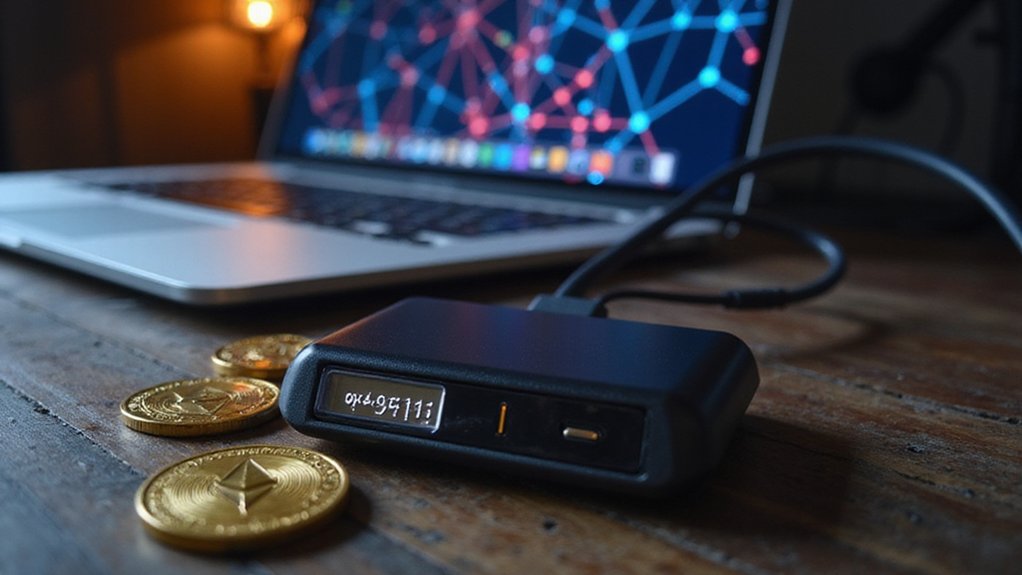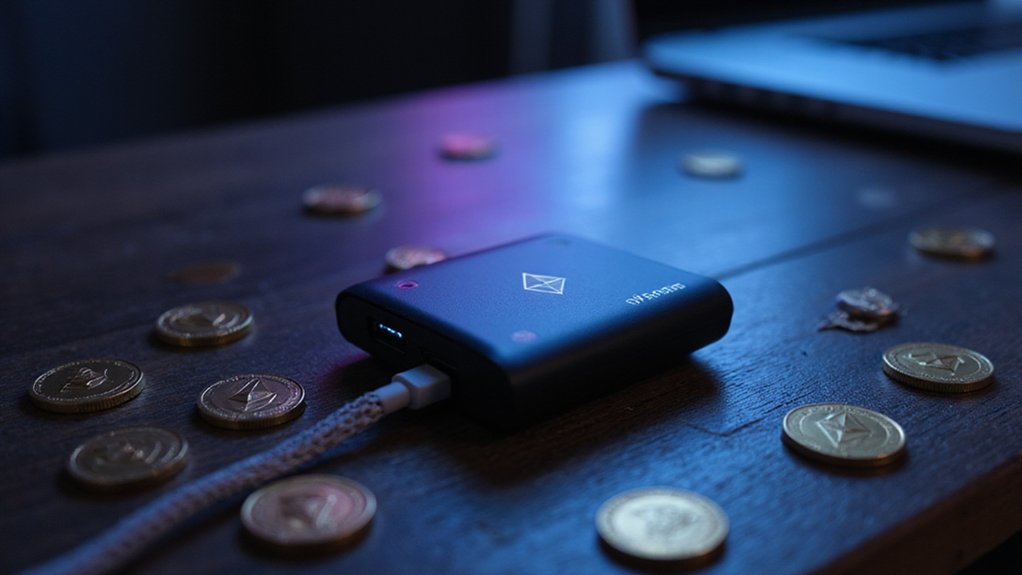An ERC20 wallet serves as a digital interface managing private keys that control tokens built on Ethereum’s blockchain, operating through unique 42-character hexadecimal addresses beginning with “0x.” These wallets—whether hardware devices like Ledger, software applications such as MetaMask, or mobile solutions—store cryptographic keys rather than actual tokens, which exist as smart contract entries. The ERC20 standard, proposed in 2015, guarantees interoperability across thousands of tokens, though the underlying mechanics reveal fascinating complexities worth exploring further.

The peculiar evolution of digital asset storage has birthed the ERC20 wallet—a software application or hardware device that serves as the digital equivalent of a leather billfold, albeit one designed to manage tokens that exist purely as mathematical abstractions on the Ethereum blockchain.
These wallets function as sophisticated gatekeepers, storing private keys linked to ERC20 token smart contracts while enabling users to send, receive, and manage their digital holdings within Ethereum’s sprawling ecosystem.
At its core, an ERC20 wallet operates through a unique 42-character hexadecimal address beginning with “0x”—a cryptographic fingerprint that serves as one’s identifier in the blockchain’s permanent ledger.
The wallet’s primary function revolves around securing private keys, those mathematical secrets that grant ownership and enable transaction signing. Without these keys, tokens become as accessible as a safety deposit box without its combination.
The ERC20 standard itself represents a triumph of standardization over chaos, establishing uniform rules for fungible tokens that guarantee interoperability across wallets, exchanges, and decentralized applications. This protocol emerged from developer Fabian Vogelsteller’s 2015 proposal to solve smart contract interoperability issues that plagued the Ethereum ecosystem. The standard mandates specific mandatory functions including totalSupply, balanceOf, transfer, approve, transferFrom, and allowance to ensure proper token management and security across all implementations.
This protocol governs popular tokens like Chainlink (LINK), Polygon (MATIC), and Aave (AAVE), allowing any compliant wallet to manage the entire spectrum of ERC20 assets from a single interface.
Wallet varieties span the security spectrum, from hardware devices like Ledger Nano X and Trezor Model T (which store keys offline in digital Fort Knox fashion) to software applications such as MetaMask and MyEtherWallet that balance convenience with protection.
Mobile wallets like Trust Wallet cater to users demanding on-the-go access, while the fundamental distinction between custodial and non-custodial options determines whether users retain direct control over their private keys or entrust them to third parties.
Security considerations extend beyond mere key storage. Hardware wallets minimize hacking risks through offline storage, while software variants employ encryption and password protection. Modern wallets increasingly implement two-factor authentication as an additional security layer, requiring secondary verification for access or transactions to prevent unauthorized access even if primary credentials are compromised.
Users must navigate the treacherous waters of phishing attacks and ascertain they’re utilizing reputable providers—a reality that underscores the curious irony of requiring extensive technical knowledge to safely store what amounts to entries in a distributed database.
Frequently Asked Questions
Can I Store Bitcoin or Other Non-Ethereum Cryptocurrencies in an ERC20 Wallet?
ERC20 wallets cannot store Bitcoin or non-Ethereum cryptocurrencies—attempting such folly results in permanent fund loss.
These wallets operate exclusively within Ethereum’s ecosystem, utilizing specific smart contract functions and address formats incompatible with Bitcoin’s blockchain architecture.
The cryptographic infrastructure differs fundamentally between networks, rendering cross-chain storage impossible.
Users requiring multi-cryptocurrency storage must employ blockchain-specific wallets or multi-chain hardware solutions rather than forcing incompatible assets into Ethereum-designed infrastructure.
What Happens if I Send ERC20 Tokens to a Wrong Wallet Address?
When ERC-20 tokens meet the wrong wallet address, outcomes vary dramatically depending on address validity and network compatibility.
Invalid addresses simply reject transactions, leaving funds untouched.
Valid but incorrect addresses create more complex scenarios—tokens sent cross-network (Ethereum to BSC) remain recoverable if users control private keys on both chains.
However, tokens dispatched to incompatible smart contracts often vanish permanently, making address verification absolutely essential before executing transfers.
How Much Does It Cost to Transfer ERC20 Tokens Between Wallets?
ERC20 token transfers incur gas fees averaging $0.68 to $1.50 on Ethereum mainnet, though network congestion can dramatically inflate costs.
Layer-2 solutions like Polygon offer transfers around $0.015—roughly 10,000 times cheaper.
Some tokens impose additional transfer fees (think 7% on certain contracts), while centralized exchanges may charge fixed withdrawal fees up to $125.
The combination creates a cost structure that makes small transfers economically questionable on mainnet.
Can I Use the Same Wallet Address for All Different ERC20 Tokens?
Yes, users can employ a single wallet address for all ERC20 tokens—a design feature that prevents the administrative nightmare of managing dozens of addresses for different assets.
The Ethereum blockchain’s architecture guarantees one address accommodates multiple token types simultaneously, with smart contracts handling the backend routing.
This unified approach streamlines portfolio management while reducing user errors, though it concentrates security risk entirely on protecting that single private key.
What’s the Difference Between Hot and Cold ERC20 Wallet Storage Options?
Hot ERC20 wallets maintain internet connectivity, prioritizing convenience for frequent trading and dApp interactions—though they’re perpetually exposed to digital threats.
Cold storage keeps private keys offline, maximizing security for long-term holdings while sacrificing accessibility.
The trade-off remains stark: hot wallets enable instant transactions but invite cyberattacks, while cold wallets protect against online threats yet require manual transfers for active use.
Most sophisticated users employ both strategically.









